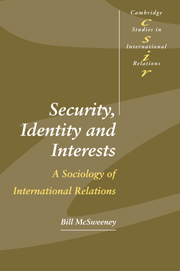Book contents
- Frontmatter
- Contents
- Acknowledgements
- Introduction
- 1 The meaning of security
- Part I Objectivist approaches to international security
- Part II Theorizing security: the turn to sociology
- 5 A conceptual discussion
- 6 The social constructionist approach
- 7 The limits of identity theory
- 8 Agency and structure in social theory
- 9 Seeing a different world: a reflexive sociology of security
- Part III Practising security
- Bibliography
- Index
- CAMBRIDGE STUDIES IN INTERNATIONAL RELATIONS
6 - The social constructionist approach
Published online by Cambridge University Press: 22 September 2009
- Frontmatter
- Contents
- Acknowledgements
- Introduction
- 1 The meaning of security
- Part I Objectivist approaches to international security
- Part II Theorizing security: the turn to sociology
- 5 A conceptual discussion
- 6 The social constructionist approach
- 7 The limits of identity theory
- 8 Agency and structure in social theory
- 9 Seeing a different world: a reflexive sociology of security
- Part III Practising security
- Bibliography
- Index
- CAMBRIDGE STUDIES IN INTERNATIONAL RELATIONS
Summary
Security cannot be reduced to defence, to a balance of threats and vulnerabilities, or to any such objective and material equation, it has been argued. Security and insecurity are a quality of a relationship, and reflect stability or change in the identity of the collectivities involved. Secondly, security relates to interests which need to be secured. The identification of the self and the identification of one's interests are problematic for the human agents involved in security policy-making at every level – from the individual infant in the nursery to the state leadership with a finger on the nuclear button. The resolution of this problem is complicated by the variable constraints and opportunities afforded by material resources and structural factors – both for the infant and the state – and it is a matter of empirical enquiry to define the degree of freedom of choice among alternatives. That there is choice, however, and that neither a fixed human nature nor an independent structure determines the direction of security policy, is a fundamental conclusion to be drawn from the analysis of this and the following chapters.
To highlight the contrast, a brief discussion of the positivist view of causality and structure in neorealism is presented before outlining a sociological approach which has become a significant source for contemporary critics of neorealism. The ‘social constructionist’ perspective is examined with a view to assessing its links with the ideas claimed to represent the anti-positivist shift in international relations theory.
Information
- Type
- Chapter
- Information
- Security, Identity and InterestsA Sociology of International Relations, pp. 101 - 125Publisher: Cambridge University PressPrint publication year: 1999
Accessibility standard: Unknown
Why this information is here
This section outlines the accessibility features of this content - including support for screen readers, full keyboard navigation and high-contrast display options. This may not be relevant for you.Accessibility Information
- 1
- Cited by
